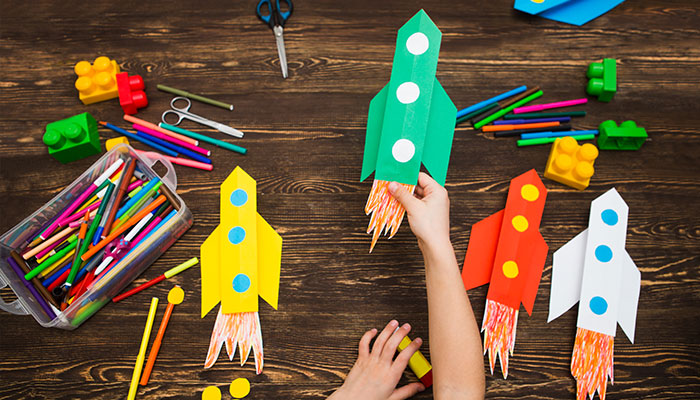While we believe that the books and resources recommended may be of value to you, keep in mind that these are suggestions only and you must do your own due diligence to determine whether the materials are appropriate and suitable for your use. PNC has no sponsorship or endorsement agreement with the authors or publishers of the materials listed.

TRANSPORTATION
Blastoff! Rocket Ships
Children will use a variety of simple materials to build a rocket ship.

Lesson Objective
Children will learn that rocket ships can travel into space and are sometimes shaped like cylinders
Science
What You'll Need
- A model or a picture of a rocket ship
- Paper towel tubes, gift wrap tubes, or oatmeal cartons
- Felt or other soft material
- Variety of scrap paper
- Bubble wrap
- Paper or foam cups and plates
- Coffee filters
- Cellophane or tissue paper in different colors
- Masking tape, glue, markers, crayons, scissors
What To Do
- Discuss rocket ships with the children (see Guiding Student Inquiry).
- Share the model rocket ship or the picture of a rocket ship. Have the children tell you about the shape of the rocket ship (see Guiding Student Inquiry).
- Tell the children they will be making rocket ships. Display the materials that they will use to make their own rocket ships. Give them time to look through the materials and plan their project (see Did You Know?).
- You can ask some guiding questions, such as “What will you use to make the body of your rocket ship?” (see Guiding Student Inquiry).
- Discuss the top of the rocket ship and ask the children what they will use to make the pointy tops of their rocket ships.
- Remind the children of the shape of the fins on the end of the rocket ship and ask what they can use to make the fins.
- Have the children begin assembling their own rocket ships.
- Assist the children with attaching their fins to their rocket ships.
- When the rocket ships are completed, have a group countdown and lift-off!
Resources
Home School Resources
Home educators: use these printable lesson PDFs to teach this lesson to your home schoolers. They're available in English and Spanish.
Content Provided By
Common Core State Standards Initiative – These lessons are aligned with the Common Core State Standards ("CCSS"). The CCSS provide a consistent, clear understanding of the concepts and skills children are expected to learn and guide teachers to provide their students with opportunities to gain these important skills and foundational knowledge [1]. Visit the CCSS


